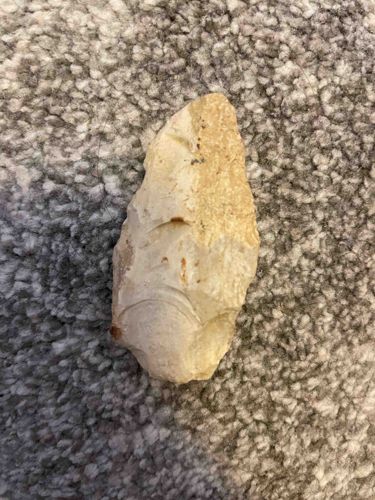
Paleolithic Stone Tool Fragment / Chert Flake
The item appears to be a lithic artifact, likely a stone tool fragment or a piece of knapped chert/flint. It is irregular in shape, tapering from a wider, somewhat rounded base to a narrower, pointed or fractured top. The material is predominantly light beige to off-white in color, with areas showing a slightly darker, more yellowish-brown hue, possibly from mineral staining or a natural variation in the stone. The surface exhibits clear conchoidal fractures, which are characteristic of flintknapping or breakage of cryptocrystalline materials. There are visible ripples and bulb of percussion features on at least one side, indicating how a flake might have been detached from a larger core. One edge appears to have been worked or utilized, showing signs of flaking, while other edges seem to be original fracture surfaces or less intentionally modified. There is no discernible maker's mark or signature. The condition appears stable for an ancient artifact, showing expected wear and patina from age and environmental exposure; there are no obvious modern repairs. Its overall form suggests it could be a spear point, knife, or scraper, though without further context or clearer angles, a definitive function is speculative. The craftsmanship implied by the flaking technique points to prehistoric origins, likely from the Stone Age, though the exact period would require expert archaeological assessment of the material type and manufacturing style.
AI-Generated Appraisal Disclaimer
Estimated Value
$75 - $150
Basic Information
Category
Archaeological Artifact/Tool
Appraised On
November 29, 2025
Estimated Value
$75 - $150
Item Description
The item appears to be a lithic artifact, likely a stone tool fragment or a piece of knapped chert/flint. It is irregular in shape, tapering from a wider, somewhat rounded base to a narrower, pointed or fractured top. The material is predominantly light beige to off-white in color, with areas showing a slightly darker, more yellowish-brown hue, possibly from mineral staining or a natural variation in the stone. The surface exhibits clear conchoidal fractures, which are characteristic of flintknapping or breakage of cryptocrystalline materials. There are visible ripples and bulb of percussion features on at least one side, indicating how a flake might have been detached from a larger core. One edge appears to have been worked or utilized, showing signs of flaking, while other edges seem to be original fracture surfaces or less intentionally modified. There is no discernible maker's mark or signature. The condition appears stable for an ancient artifact, showing expected wear and patina from age and environmental exposure; there are no obvious modern repairs. Its overall form suggests it could be a spear point, knife, or scraper, though without further context or clearer angles, a definitive function is speculative. The craftsmanship implied by the flaking technique points to prehistoric origins, likely from the Stone Age, though the exact period would require expert archaeological assessment of the material type and manufacturing style.
Get Your Items Appraised
Instant estimates of your treasures with AI-powered instant appraisals